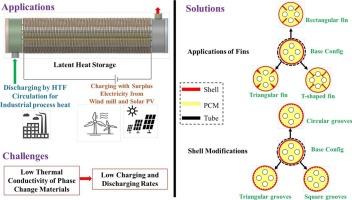Harnessing off-peak renewable electricity via resistive heating in solar salt based latent heat storage: Performance enhancement through fins and shell configurations
IF 8.9
2区 工程技术
Q1 ENERGY & FUELS
引用次数: 0
Abstract
Phase change material based thermal energy storage is a better choice due to its high energy density and charging and discharging occur at nearly constant temperature. In the present study, solar salt (60 % NaNO3 + 40 % KNO3) is considered as the storage media. Various passive performance enhancement techniques are analyzed by attaching fins (rectangular, triangular, and T-shaped fins) and grooves (circular, triangular, and square grooves) on the shell side for charging of the storage media. To quantitatively assess the impact of fins and shell configurations on the performance of latent heat storage system, complete melting time, maximum rise in phase change material temperature, and the portion of total energy utilized for the phase change are used as performance evaluation indexes. In particular, focus is given to justify the contribution of the average circulation velocity of phase change material to melting rate. The results indicate that fins significantly reduce both the melting time and the maximum temperature rise in the PCM domain as compared to various shell configurations. In comparison with all studied configurations, rectangular fin with 3.81 cm radial length have maximum reduction in melting time of 7.4 % and triangular fin with 3.81 cm radial length have a maximum reduction in temperature rise of 33 K. The study shows that increasing fin radial length enhances charging performance. Although melting starts earlier in the base configuration, fins complete melting faster by distributing heat inward. Raising the heat flux from 0.5 kW/m2 to 14 kW/m2 shortened the charging time by 21.8 times but also caused significant superheating, increasing the local maximum temperature of the phase change material from 512 K to 723 K, with the proportion of superheated energy rising from 2.8 % to 22.9 % of the total heat input.

通过太阳能盐基潜热储存中的电阻加热利用非峰值可再生电力:通过翅片和外壳配置增强性能
相变材料储能具有高能量密度和几乎恒定温度下的充放电特性,是较好的选择。本研究采用太阳盐(60% NaNO3 + 40% KNO3)作为存储介质。通过在壳体侧面附加翅片(矩形、三角形和t形翅片)和凹槽(圆形、三角形和方形凹槽)对存储介质进行充电,分析了各种被动性能增强技术。为了定量评价翅片和壳结构对潜热蓄热系统性能的影响,采用完全熔化时间、相变材料温度最大上升、相变所利用总能量的比例作为性能评价指标。重点讨论了相变材料的平均循环速度对熔化速率的影响。结果表明,与不同的壳体结构相比,翅片显著缩短了PCM畴内的熔化时间和最高温升。与所有构型相比,径向长度为3.81 cm的矩形翅片最大缩短了7.4%的熔化时间,而径向长度为3.81 cm的三角形翅片最大缩短了33 K的温升。研究表明,增加翅片径向长度可以提高装药性能。虽然在基本结构中熔化开始得更早,但翅片通过向内分配热量而更快地完成熔化。将热流密度从0.5 kW/m2提高到14 kW/m2,充电时间缩短了21.8倍,但相变材料的局部最高温度从512 K提高到723 K,过热能量占总热输入的比例从2.8%提高到22.9%。
本文章由计算机程序翻译,如有差异,请以英文原文为准。
求助全文
约1分钟内获得全文
求助全文
来源期刊

Journal of energy storage
Energy-Renewable Energy, Sustainability and the Environment
CiteScore
11.80
自引率
24.50%
发文量
2262
审稿时长
69 days
期刊介绍:
Journal of energy storage focusses on all aspects of energy storage, in particular systems integration, electric grid integration, modelling and analysis, novel energy storage technologies, sizing and management strategies, business models for operation of storage systems and energy storage developments worldwide.
 求助内容:
求助内容: 应助结果提醒方式:
应助结果提醒方式:


